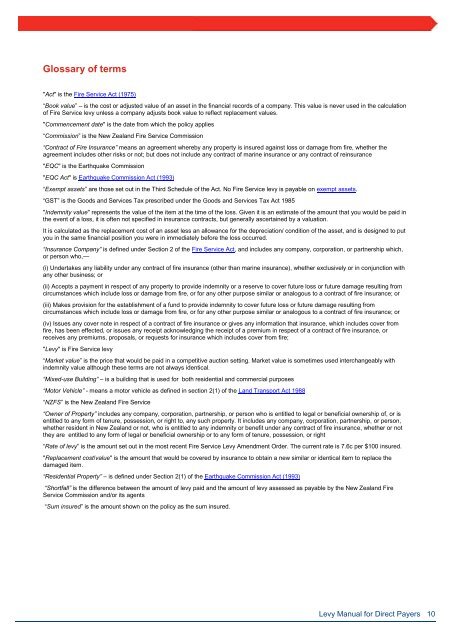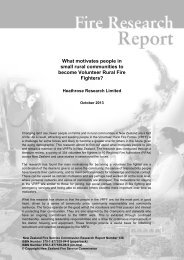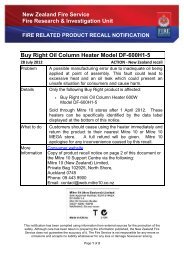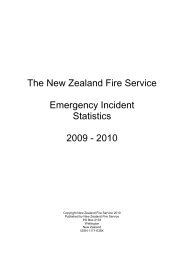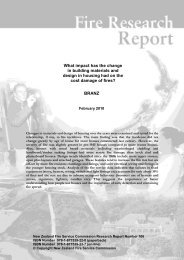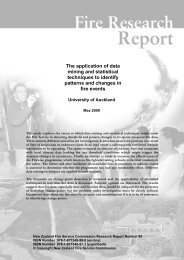A guide to the New Zealand Fire Service Levy
A guide to the New Zealand Fire Service Levy
A guide to the New Zealand Fire Service Levy
Create successful ePaper yourself
Turn your PDF publications into a flip-book with our unique Google optimized e-Paper software.
Glossary of terms<br />
"Act" is <strong>the</strong> <strong>Fire</strong> <strong>Service</strong> Act (1975)<br />
―Book value‖ – is <strong>the</strong> cost or adjusted value of an asset in <strong>the</strong> financial records of a company. This value is never used in <strong>the</strong> calculation<br />
of <strong>Fire</strong> <strong>Service</strong> levy unless a company adjusts book value <strong>to</strong> reflect replacement values.<br />
"Commencement date" is <strong>the</strong> date from which <strong>the</strong> policy applies<br />
―Commission‖ is <strong>the</strong> <strong>New</strong> <strong>Zealand</strong> <strong>Fire</strong> <strong>Service</strong> Commission<br />
“Contract of <strong>Fire</strong> Insurance” means an agreement whereby any property is insured against loss or damage from fire, whe<strong>the</strong>r <strong>the</strong><br />
agreement includes o<strong>the</strong>r risks or not; but does not include any contract of marine insurance or any contract of reinsurance<br />
"EQC" is <strong>the</strong> Earthquake Commission<br />
"EQC Act" is Earthquake Commission Act (1993)<br />
―Exempt assets‖ are those set out in <strong>the</strong> Third Schedule of <strong>the</strong> Act. No <strong>Fire</strong> <strong>Service</strong> levy is payable on exempt assets.<br />
―GST‖ is <strong>the</strong> Goods and <strong>Service</strong>s Tax prescribed under <strong>the</strong> Goods and <strong>Service</strong>s Tax Act 1985<br />
"Indemnity value" represents <strong>the</strong> value of <strong>the</strong> item at <strong>the</strong> time of <strong>the</strong> loss. Given it is an estimate of <strong>the</strong> amount that you would be paid in<br />
<strong>the</strong> event of a loss, it is often not specified in insurance contracts, but generally ascertained by a valuation.<br />
It is calculated as <strong>the</strong> replacement cost of an asset less an allowance for <strong>the</strong> depreciation/ condition of <strong>the</strong> asset, and is designed <strong>to</strong> put<br />
you in <strong>the</strong> same financial position you were in immediately before <strong>the</strong> loss occurred.<br />
“Insurance Company” is defined under Section 2 of <strong>the</strong> <strong>Fire</strong> <strong>Service</strong> Act, and includes any company, corporation, or partnership which,<br />
or person who,—<br />
(i) Undertakes any liability under any contract of fire insurance (o<strong>the</strong>r than marine insurance), whe<strong>the</strong>r exclusively or in conjunction with<br />
any o<strong>the</strong>r business; or<br />
(ii) Accepts a payment in respect of any property <strong>to</strong> provide indemnity or a reserve <strong>to</strong> cover future loss or future damage resulting from<br />
circumstances which include loss or damage from fire, or for any o<strong>the</strong>r purpose similar or analogous <strong>to</strong> a contract of fire insurance; or<br />
(iii) Makes provision for <strong>the</strong> establishment of a fund <strong>to</strong> provide indemnity <strong>to</strong> cover future loss or future damage resulting from<br />
circumstances which include loss or damage from fire, or for any o<strong>the</strong>r purpose similar or analogous <strong>to</strong> a contract of fire insurance; or<br />
(iv) Issues any cover note in respect of a contract of fire insurance or gives any information that insurance, which includes cover from<br />
fire, has been effected, or issues any receipt acknowledging <strong>the</strong> receipt of a premium in respect of a contract of fire insurance, or<br />
receives any premiums, proposals, or requests for insurance which includes cover from fire;<br />
"<strong>Levy</strong>" is <strong>Fire</strong> <strong>Service</strong> levy<br />
―Market value‖ is <strong>the</strong> price that would be paid in a competitive auction setting. Market value is sometimes used interchangeably with<br />
indemnity value although <strong>the</strong>se terms are not always identical.<br />
“Mixed-use Building” – is a building that is used for both residential and commercial purposes<br />
“Mo<strong>to</strong>r Vehicle” - means a mo<strong>to</strong>r vehicle as defined in section 2(1) of <strong>the</strong> Land Transport Act 1988<br />
―NZFS‖ is <strong>the</strong> <strong>New</strong> <strong>Zealand</strong> <strong>Fire</strong> <strong>Service</strong><br />
“Owner of Property” includes any company, corporation, partnership, or person who is entitled <strong>to</strong> legal or beneficial ownership of, or is<br />
entitled <strong>to</strong> any form of tenure, possession, or right <strong>to</strong>, any such property. It includes any company, corporation, partnership, or person,<br />
whe<strong>the</strong>r resident in <strong>New</strong> <strong>Zealand</strong> or not, who is entitled <strong>to</strong> any indemnity or benefit under any contract of fire insurance, whe<strong>the</strong>r or not<br />
<strong>the</strong>y are entitled <strong>to</strong> any form of legal or beneficial ownership or <strong>to</strong> any form of tenure, possession, or right<br />
―Rate of levy‖ is <strong>the</strong> amount set out in <strong>the</strong> most recent <strong>Fire</strong> <strong>Service</strong> <strong>Levy</strong> Amendment Order. The current rate is 7.6c per $100 insured.<br />
"Replacement cost/value" is <strong>the</strong> amount that would be covered by insurance <strong>to</strong> obtain a new similar or identical item <strong>to</strong> replace <strong>the</strong><br />
damaged item.<br />
“Residential Property” – is defined under Section 2(1) of <strong>the</strong> Earthquake Commission Act (1993)<br />
“Shortfall” is <strong>the</strong> difference between <strong>the</strong> amount of levy paid and <strong>the</strong> amount of levy assessed as payable by <strong>the</strong> <strong>New</strong> <strong>Zealand</strong> <strong>Fire</strong><br />
<strong>Service</strong> Commission and/or its agents<br />
―Sum insured‖ is <strong>the</strong> amount shown on <strong>the</strong> policy as <strong>the</strong> sum insured.<br />
<strong>Levy</strong> Manual for Direct Payers 10


